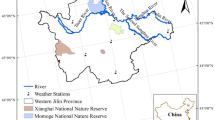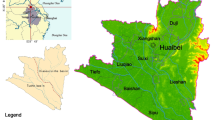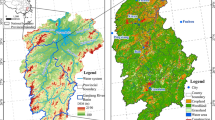Abstract
Human activity together with climatic changes have resulted in the substantial loss of wetlands in the Tumen River Basin of China in the past five decades. In this study, the landscape dynamics of wetlands upstream, midstream and downstream of the Tumen River Basin from 1960 to 2009 were investigated using remote sensing and geographic information systems. Analytical methods, such as dynamic degree, transfer matrix and indices, e.g., patch number (NP), area percentage of landscape patches, mean patch size, patch density, Shannon’s diversity index (SHDI), and Shannon’s evenness index (SHEI), were utilized to describe the landscape dynamics. The results showed that over the past 50 years, human-made wetlands, including paddy fields and reservoirs, increased, whereas natural wetlands, including marshes, lakes and rivers, decreased. In the study period, a large number of natural wetlands were converted by humans into other types of wetlands and non-wetlands. For wetland landscape changes, the NP, landscape fragmentation index, and SHEI increased, whereas the average patch area and SHDI decreased. In addition, we found that human factors were the main driving forces for the reduction of natural wetlands in this area, among which agricultural activities had the strongest impact. Great losses of natural wetlands have led to ecological problems in the region, such as a decline in biodiversity and soil degradation.




Similar content being viewed by others
References
Alados CL, EIAich A, Papanastasis VP, Ozbek H, Navarro T, Freitasf H, Vrahnakisc M, Larrosib D, Cabezudoe B (2004) Change in plant spatial patterns and diversity along the successional gradient of Mediterranean grazing ecosystems. Ecol Model 180(4):523–535
Bai J, Ouyang H, Cui B, Wang Q, Chen H (2008) Changes in landscape pattern of alpine wetlands on the Zoige Plateau in the past four decades. Acta Ecol Sin 28(5):2245–2252
Davis J, Brock M (2008) Detecting unacceptable change in the ecological character of Ramsar wetlands. Ecol Manage Restor 9(1):26–32
Dawson TP, Berry PM, Kampa E (2003) Climate change impacts on freshwater wetland habitats. J Nat Conserv 11(1):25–30
Dong Z, Wang Z, Liu D, Song K, Li L, Jia M, Ding Z (2014) Mapping wetland areas using landsat-derived NDVI and LSWI: a case study of West Songnen Plain, Northeast China. J Indian Soc Remote Sens 42(3):569–576
Fu B, Zhao W, Chen L, Liu Z, Lü Y (2005) Eco-hydrological effects of landscape pattern change. Landsc Ecol Eng 1(1):25–32
Fukushima T, Takahashi M, Matsushita B, Okanishi Y (2007) Land use/cover change and its drivers: a case in the watershed of Lake Kasumigaura, Japan. Landsc Ecol Eng 3(1):21–31
Gong P, Niu Z, Cheng X, Zhao K, Zhou D, Guo J, Liang L, Wang X, Li D, Huang H, Wang Y, Wang K, Li W, Wang X, Ying Q, Yang Z, Ye Y, Li Z, Zhuang D, Chi Y, Zhou H, Yan J (2010) China’s wetland change (1990–2000) determined by remote sensing. Sci China Earth Sci 53(7):1036–1042
He X, Gao Y, Niu J, Zhao Y (2011) Landscape pattern changes under the impacts of urbanization in the Yellow River wetland—king Zhengzhou as an example. Proc Env Sci 10(C):2165–2169
Jiang P, Cheng L, Li M, Zhao R, Huang Q (2014) Analysis of landscape fragmentation processes and driving forces in wetlands in arid areas: a case study of the middle reaches of the Heihe River, China. Ecol Indic 46:240–252
Kang S, Kim JO (2015) Morphological analysis of green infrastructure in the Seoul metropolitan area, South Korea. Landsc Ecol Eng 11(2):259–268
Khaznadar M, Vogiatzakis IN, Griffiths GH (2009) Land degradation and vegetation distribution in Chott El Beida wetland, Algeria. J Arid Env 73(3):369–377
Kim JO, Suh JH (2016) A review of climate change adaptation policies applied to landscape planning and design in Korea. Landsc Ecol Eng 12(1):171–177
Kong W, Sun OJ, Xu W, Chen Y (2009) Changes in vegetation and landscape patterns with altered river water-flow in arid West China. J Arid Env 73(3):306–313
Langford WT, Gergel SE, Dietterich TG, Cohen W (2006) Map misclassification can cause large errors in landscape pattern indices: examples from habitat fragmentation. Ecosystems 9(3):474–488
Lee DK, Park C, Tomlin D (2015) Effects of land-use-change scenarios on terrestrial carbon stocks in South Korea. Landsc Ecol Eng 11(1):47–59
Li X, Wang Z, Song K, Zhang B, Liu D, Guo Z (2007) Assessment for salinized wasteland expansion and land use change using GIS and remote sensing in the west part of Northeast China. Env Monit Assess 131(1):421–437
Li X, Xue Z, Gao J (2016) Dynamic changes of plateau wetlands in Madou County, the Yellow River source zone of China: 1990–2013. Wetland 36(2):299–310
Liu D, Wang Z, Song K, Zhang B, Hu L, Huang N, Zhang S, Luo L, Zhang C, Jiang G (2009) Land use/cover changes and environmental consequences in Songnen Plain, Northeast China. Chin Geogr Sci 19(4):299–305
Lü X, Jiang M (2004) Progress and prospect of wetland research in China. J Geogr Sci 14(1):45–51
Lu D, Moran E, Batistella M (2003) Linear mixture model applied to Amazonian vegetation classification. Remote Sens Env 87(4):456–469
Maltchik L, Lanés LEK, Keppeler FW, Rolon AS, Stenert C (2014) Landscape and habitat characteristics associated with fish occurrence and richness in southern Brazil palustrine wetland systems. Env Biol Fish 97(3):297–308
Merot P, Squividant H, Aurousseau P, Hefting M, Burt T, Maitre V, Kruk M, Butturini A, Thenail C, Viaud V (2003) Testing a climato-topographic index for predicting wetlands distribution along an European climate gradient. Ecol Model 163(1–2):51–71
Mitsch WJ, Hernandez ME (2013) Landscape and climate change threats to wetlands of North and Central America. Aquat Sci 75(1):133–149
Nan Y, Ji Z, Feng H, Zhang C (2013) On eco-security evaluation in the Tumen River region based on RS & GIS. Acta Ecol Sin 33(15):4790–4798 (in Chinese)
Song K, Wang Z, Li L, Tedesco L, Li F, Jin C, Du J (2012) Wetlands shrinkage, fragmentation and their links to agriculture in the Muleng–Xingkai Plain, China. J Env Manage 111:120–132
State Forestry Administration (SFA) (2005) China forestry yearbook 2005. China Forestry Press, Beijing (in Chinese)
Sueltenfuss JP, Cooper DJ, Knight RL, Waskom RM (2013) The creation and maintenance of wetland ecosystems from irrigation canal and reservoir seepage in a semi-arid landscape. Wetlands 33(5):799–810
Sulman BN, Desai AR, Mladenoff DJ (2013) Modeling soil and biomass carbon responses to declining water table in a wetland-rich landscape. Ecosystems 16(3):491–507
Sutula MA, Perez BC, Reyes E, Childers DL, Davis S, Day JW Jr, Rudnick D, Sklar F (2003) Factors affecting spatial and temporal variability in material exchange between the Southern Everglades wetlands and Florida Bay (USA). Estuar Coast Shelf Sci 57(5–6):757–781
Walker CM, King RS, Whigham DF, Baird SJ (2012) Landscape and wetland influences on headwater stream chemistry in the Kenai Lowlands, Alaska. Wetlands 32(2):301–310
Wang Z, Huang N, Luo L, Li X, Ren C, Song K, Chen J (2011) Shrinkage and fragmentation of marshes in the West Songnen Plain, China, from 1954 to 2008 and its possible causes. Int J Appl Earth Obs Geoinf 13(3):477–486
Wang Z, Wu J, Madden M, Mao D (2012) China’s wetlands: conservation plans and policy impacts. Ambio 41(7):782–786
Wang J, Ren H, Yang L, Liu N (2013) Seedling morphological characteristics and seasonal growth of indigenous tree species transplanted into four plantations in South China. Landsc Ecol Eng 9(2):203–212
Weber A, Fohrer N, Möller D (2001) Long-term land use changes in a mesoscale watershed due to socio-economic factors—effects on landscape structures and functions. Ecol Model 140(1–2):125–140
Zhao R, Chen Y, Zhou H, Li Y, Qian Y, Zhang L (2009) Assessment of wetland fragmentation in the Tarim River Basin, western China. Env Geol 57(2):455–464
Zhao W, Liu B, Zhang Z (2010) Water requirements of maize in the middle Heihe River basin, China. Agric Water Manage 97(2):215–223
Zhu W, Koo BH (2006) Wetlands classifying characteristics by wetland classifying systems-cases on the Tumen River and Han River. J Korea Soc Env Restor Technol 9(6):152–161
Zhu W, Nan Y, Liu Z, Wang Q, Cheng H, Junichi I, Yukihiro M (2007) Study on wetland classification and distribution in the Tumen River lower stream area based on 3S technologies. J Northeast Norm Univ (Natl Sci Ed) 39(3):106–113 (in Chinese)
Zhu W, Miao C, Zheng X, Cao G, Wang F (2014) Study on ecological safety evaluation and warning of wetlands in Tumen River watershed based on 3S technology. Acta Ecol Sin 34(6):1379–1390 (in Chinese)
Acknowledgements
This research was supported by the National Natural Science Foundation of China (Grant Nos. 41361015 and 40961011), the international cooperation projects of Jilin Province (Grant No. 20120740), and the Jilin Province Science and Technology Development Plan Project Commitments (Grant No. 20130206007SF). The authors are grateful for the comments and contributions of anonymous reviewers and members of the editorial team.
Author information
Authors and Affiliations
Corresponding author
Rights and permissions
About this article
Cite this article
Zheng, X.J., Sun, P., Zhu, W.H. et al. Landscape dynamics and driving forces of wetlands in the Tumen River Basin of China over the past 50 years. Landscape Ecol Eng 13, 237–250 (2017). https://doi.org/10.1007/s11355-016-0304-8
Received:
Revised:
Accepted:
Published:
Issue Date:
DOI: https://doi.org/10.1007/s11355-016-0304-8




